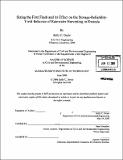Sizing the first flush and its effect on the storage-reliability-yield behavior of rainwater harvesting in Rwanda
Author(s)
Doyle, Kelly C. (Kelly Carroll)
DownloadFull printable version (88.57Mb)
Other Contributors
Massachusetts Institute of Technology. Dept. of Civil and Environmental Engineering.
Advisor
Peter Shanahan.
Terms of use
Metadata
Show full item recordAbstract
Rainwater harvesting is a technology used to supply water for domestic purposes in developing countries. Rooftop rainwater harvesting involves collection of rainwater from a rooftop via a guttering system and storage in a cistern. During dry weather, dust and other pollutants accumulate on the roof surface and are washed off at the beginning of the next rain. The initial contaminated volume of water flowing from a roof after a rainstorm is known as the first flush and research has shown that diverting it from the main supply can improve the quality of stored water. This thesis considers a variety of design options for rainwater harvesting, set in the context of rural Bisate Village in northwestern Rwanda. Fieldwork evaluated the potential for rainwater harvesting at three community-scale locations; a health clinic, a primary school, and a house for gorilla trackers and by analysis of the water quality, sought to characterize the first flush phenomenon using an apparatus to collect discrete time-sequenced volumes of runoff. The reliability of a rainwater harvesting system is a measure of its ability to produce the water needed by the system users and depends partially upon the rainfall distribution of the area, the size of the collection roof, the capacity of the storage tank, and the daily demand for the water. The storage-reliability-yield (SRY) behavior of a rainwater harvesting system indicates trends in reliability as storage (cistern size) and yield (demand) are varied. A SRY simulation model was run to mimic daily use of the system and calculate the reliability. The recommended first flush diversion was simulated and evaluated against several management options. The simulations showed that the reliability is not drastically affected by diversion of the first flush. (cont.) The author recommends that the first millimeter of runoff be diverted from the roof after three consecutive days of precipitation less than one millimeter. This recommendation is case-specific but should greatly improve the quality of water stored in the tanks, improving the health of the end users.
Description
Thesis (S.M.)--Massachusetts Institute of Technology, Dept. of Civil and Environmental Engineering, 2008. Includes bibliographical references (p. 112-119).
Date issued
2008Department
Massachusetts Institute of Technology. Department of Civil and Environmental EngineeringPublisher
Massachusetts Institute of Technology
Keywords
Civil and Environmental Engineering.